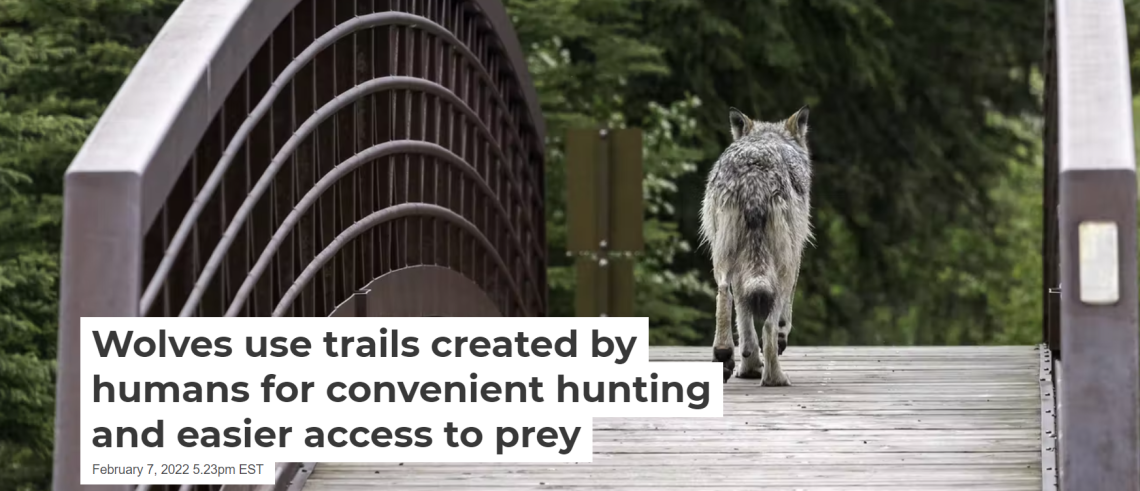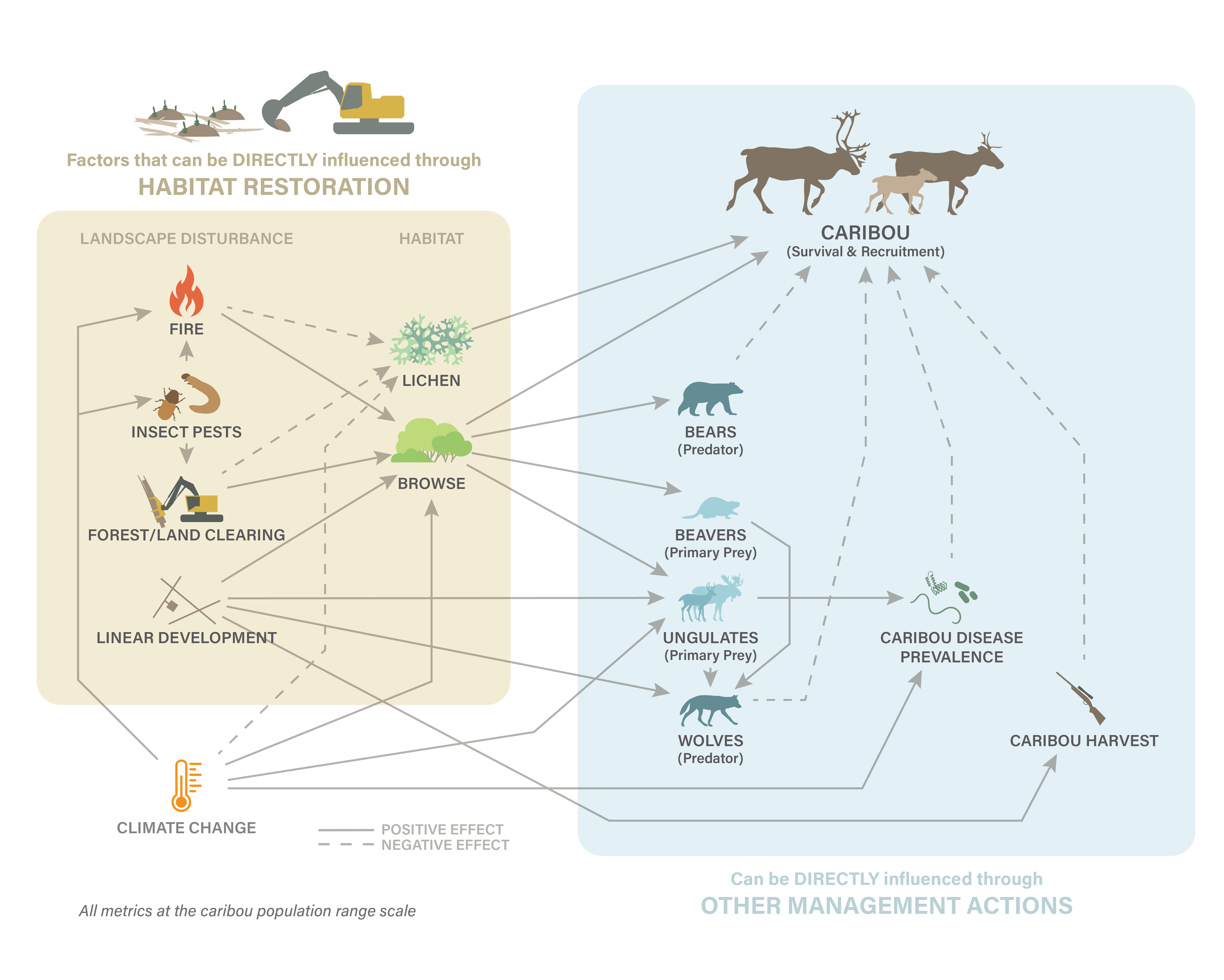Habitat management
Content related to: Habitat management
Witnessing Extinction – Cumulative Impacts Across Landscapes and the Future Loss of an Evolutionarily Significant Unit of Woodland Caribou in Canada
Witnessing Extinction – Cumulative Impacts Across Landscapes and the Future Loss of an Evolutionarily Significant Unit of Woodland Caribou in Canada
Widespread Declines in Woodland Caribou (Rangifer tarandus caribou) Continue in Alberta
Scientific Assessment to Inform the Identification of Critical Habitat for Woodland Caribou (Rangifer tarandus caribou), Boreal Population, in Canada - 2011 Update
Spatial Patterning of Prey at Reproduction to Reduce Predation Risk: What Drives Dispersion from Groups?
Crossing Caribou Country: A special Report Assessing the Impacts of New Transmission Line Routes on Threatened Caribou in NW Ontario
Wolves use trails created by humans for convenient hunting and easier access to prey

Zoom in and explore the northern boreal forests of western Canada on Google Earth and you’ll see long straight lines making their way through the forest. These lines are cleared trails through the forest to extract resources, creating roads for forestry and seismic lines searching for underground oil and gas deposits.
Now picture yourself faced with the task of moving across this landscape: Will you push your way through dense trees and underbrush, or will you choose to walk on the trails?
Like humans, wolves often choose the path of least resistance, moving faster and farther on human-created trails through the forest. Increased wolf movement is believed to play an important role in the decline of the threatened boreal woodland caribou— an iconic species in Canada (just look at the quarter in your pocket).
When wolves move farther, they encounter their prey more frequently, and caribou are being hunted by wolves at rates they cannot sustain.
See the full article here
Habitat Restoration Across the Klinse-Za Caribou Herd Range
The Klinse-Za herd area, located between Mackenzie, Chetwynd and the Peace Arm of Williston reservoir, used to support a herd of almost 200 caribou as recently as 1995 and was said to be so numerous in historic times as be “like bugs on the land”. However, the herd has declined to under 40 individuals by 2013. Across BC, many caribou herds have experienced the same steep declines, and most of the struggling herds are inhabiting areas with generally more human disturbance and activity on the landscape. Specifically, industrial development has contributed to caribou declines as their habitat has been altered, displacing the caribou and making them more susceptible to predation. Since 2013, costly and intensive management efforts including maternity penning and predator removal have helped halt or reduce the rate of decline in some herds. However, these activities are not going to keep caribou on the land base over the long term. To improve caribou habitat, support the ecosystem and balance the predator-prey dynamics, we are implementing a large-scale habitat restoration project in the Klinse-za caribou herd area.
Restoration of habitat can involve a variety of activities. In the Klinse-za habitat restoration program, we focus our efforts on reforesting and restructuring linear features (e.g., old roads, seismic lines). This will limit the ability of predators to easily access caribou habitat and minimize caribou- predator interactions. Over time, reforesting the features will return the ecosystem to a more natural state.
See this (gorgeous) short film for more informaiton: Caribou Homeland
The Boreal Caribou Ecological Model
The Boreal Caribou Ecological Model
Developed by the Habitat Restoration Working Group (HRWG) of the National Boreal Caribou Knowledge Consortium (NBCKC).
Habitat restoration is expected to play a key role in the recovery of boreal woodland caribou (Rangifer tarandus caribou) in Canada. Population declines are correlated with the proportion of ranges affected by anthropogenic and natural disturbances and reversing these impacts is expected to benefit caribou populations. However, there are various mechanisms that lead from habitat stressors to caribou declines, and the effects of these mechanisms differ among ranges.
Understanding the ecological pathways driving observed relationships can inform restoration planning by:
- directing treatments towards the most critical, range-specific mechanisms;
- identifying possible confounding factors that need to be addressed; and,
- supporting adaptive management by generating testable hypotheses and clarifying monitoring needs.
Here we present a conceptual Boreal Caribou Ecological Model developed by the Habitat Restoration Working Group of the National Boreal Caribou Knowledge Consortium. The model is composed of 14 factors and associated relationships that generate pathways leading from a variety of landscape disturbance stressors. The model does not capture all possible factors in the system, but only those that are likely exerting significant effects. Nor does it address specific restoration treatment options but it can inform the design of treatments by identifying the functional effects that treatments should be addressing.
Caribou survival and recruitment are affected directly by predation, nutrition, disease and hunting. All of these link back to one or more habitat stressors that drive the national disturbance model (i.e., fire, insect pests, forest alteration/clearing and linear development). The individual relationship pathways interact with each other and can also be affected by external factors. The habitat stressors alter forage available to caribou and to other primary prey, the distribution and abundance of primary prey, associated predators and of humans, and ultimately cause population declines via lower caribou survival and reproductive success.
A key next step for the conceptual model is the development of appropriate response metrics to monitor response to restoration efforts. This would provide the means to compare the relative effects of different drivers among ranges and would highlight key knowledge gaps. The model would then provide a complete framework for adaptive management as habitat restoration is implemented.

links to the Tools developed by the Habitat Restoration Working Group:
- The Boreal Caribou Ecological Model (current page)
To learn more about caribou habitat restoration please visit our 'Caribou Habitat Restoration' page [under development].

